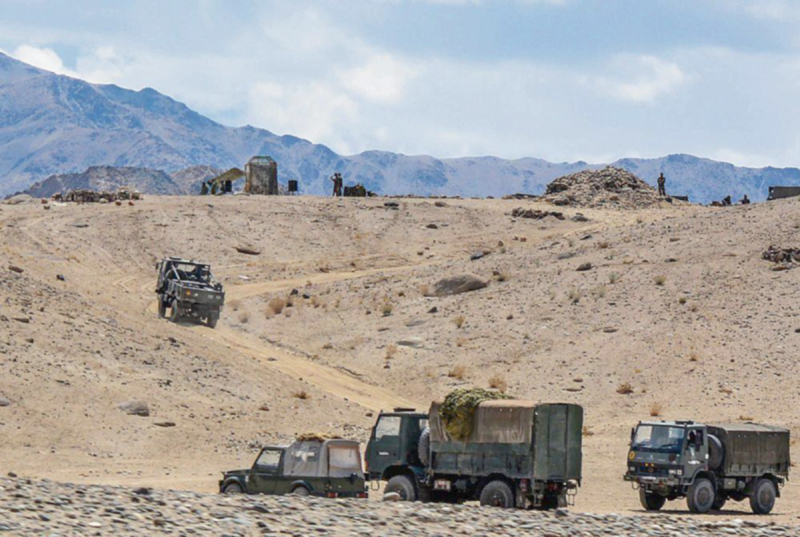Y-j on the Depsang
By Bharat Karnad
Speaking at the Bloomberg Economic Summit external yesterday affairs minister S Jaishankar hinted at resolution of the border problems with China being sought through a yet higher channel than the Special Representatives level talks (involving Ajit Doval and Wang Yi) involving, apparently, Jaishankar and Wang. “Discussions are on, but what is going on in that forum”, said Jaishankar somewhat mysteriously, “is something confidential between us and the Chinese.”
Well, Jaishankar better produce a rabbit out of that hat because nothing else has so far worked. The MEA spokesperson was just as opaque, stating only that the two sides “exchanged serious proposals”. The Indian government says its sole interest is in arriving at a “comprehensive” disengagement covering all territorial friction points, meaning restoration of the status quo ante.
Meanwhile, Beijing has been just as definite that if that’s what Delhi is waiting for it will have to wait for a very, very long time, if ever. Because it is interested for the nonce only in a Ladakh-specific remedy involving the Chinese PLA staying put in virtually all the areas they have intruded into across the LAC while asking the Indian army to decamp from its forward positions.
On this issue the Chinese urgently demand the Indian army vacate the heights it occupied around the Spanggur Lake in surprise moves that, for a change, froze the PLA out of the Rezangla ridge line that also includes ‘Black Top’ the highest point in that mountain range, which enables the Indian army to mount effective surveillance of the Chinese troop movements in the extended area and to launch timely counter actions to frustrate any offensive PLA activity.
But then, as happened very early in the confrontation when MEA offered the indistinctness of the LAC on the map and on the ground as reason for the hostile interface which the Xi regime thereafter used to justify all that transpired subsequently in eastern Ladakh, the MEA spokesperson this time around fouled up by once again offering the Chinese Foreign Office new talking points.
He explained the lack of progress in the various parlays afoot by referring to the “complexity” of the disengagement process. “The two sides”, he averred, “have a better understanding of each other’s positions. Disengagement is a complex process that requires redeployment of troops by each side towards their regular posts on their respective sides of the LAC.” The Chinese negotiators can be expected to hereon gleefully embrace this so-called “complexity” of the mutual withdrawal process to stall all proceedings, and otherwise bring them to an impasse, and use it as plausible cause for refusing to back out of the annexed Indian Territory.
Lately, and it is a bit a rich this, but Chinese Foreign Office spokesman have now taken to blaming India’s infrastructure buildup along the LAC as “the root cause of tensions” and implied that continuing with this activity besides “complicating the situation” would prevent “peace and tranquility” from returning on the LAC. To which his Indian counterpart, diffident and mealymouthed as always, stressed the need for both sides to adhere to all previous accords “in their entirety”.
Why can’t Jaishankar instruct his ministry spokesman to emulate the latter’s Chinese counterpart and vociferously demand the Chinese hand back all territory taken by force, and relinquish the infrastructure built up in the Aksai Chin the first of which was the Xinjiang Highway constructed starting in 1955-56, and refer to this as, in fact, “the root cause” of all bilateral troubles and ill-will? These are two lines and their variants that should be iterated with vehemence and absolute conviction every time MEA spokespersons open their mouth.
But why do Indian diplomats come out like shrinking violets when compared to the Chinese Foreign Service staffers? In part because the former think their forte is the English language and they can weave a web of words to entangle the Chinese.
In actuality, however, it is the new breed of Chinese diplomats posted to Delhi and in Zhongnanhai who speak good English, often are far better read and informed, and who, language-wise, end up hoisting Indians with their own petard. Worse, when these MEA-wallahs can’t think of anything to say to the press they fall back on recounting the spurious tactical advantage the Indian army has supposedly gained on the Finger 4 feature on the Pangong Tso (spurious because the area Finger 4 to Finger 8 has already been lost to the PLA) and about the more real gain, courtesy the Spanggur-Rezangla area under Indian control.
But what they never mention is the crucial and significant negative of the extant state of affairs the 960 odd sq kms northwestwards of the Y-junction to the Karakorum Pass on the Depsang Plains in PLA’s hands. The Chinese have achieved this by simply blocking Indian troops from accessing India’s traditional patrolling points beyond the junction.
That XIV Corps and Indian army HQrs have not so far thought it worth their while to plan and execute an Indian army operation, obviously by Special Forces, to outflank and isolate PLA’s blocking force by going around the mountain range on the Y-junction rather than waiting around for the PLA to permit Indian patrols, is pretty much allowing this bit of Indian territory to settle in China’s lap.
This lack of military initiative where China is concerned, alas, reflects the civilianizing of the military leadership and not in a good way to a point where risk-aversion has become part of the institutional DNA and central to the thinking of the military brass. Like our political leaders, our armed services chiefs too have learned to talk big, act small.


